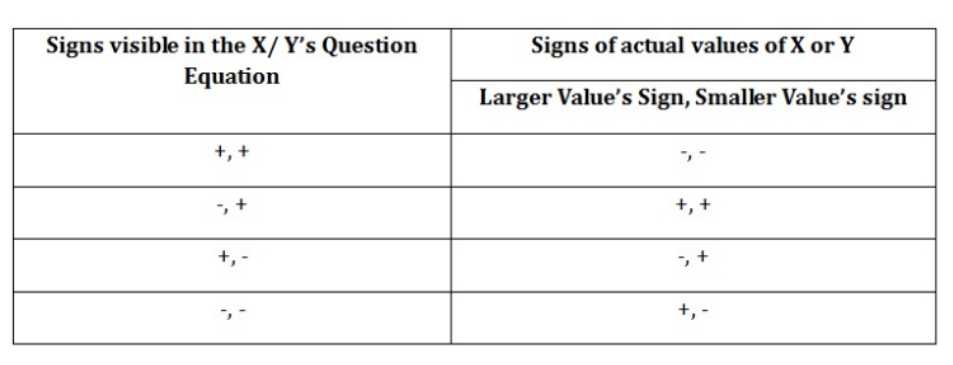
Key Concepts for Quadratic Equation: A quadratic polynomial, when equated to zero, becomes a quadratic equation. In other terms, a quadratic equation is a second-degree algebraic equation. The values of x satisfying the equation are called the roots of the quadratic equation.
General form: a x 2 +bx+c=0 where x represents an unknown, and a, b, and c are constants with a not equal to 0 . The constants a, b, and c are usually real numbers, but they can be complex numbers as well. Quadratic equation examples: x 2 +5x+6=0 , 6 x 2 -17x+12=0Quadratic Equation Formula
 The Quadratic Equation Formula expresses the solutions in terms of a , b , and c .
The Quadratic Equation Formula expresses the solutions in terms of a , b , and c .
Best Quadratic Equation Examples
In each question, two equations will be given. You have to solve the equations and choose the appropriate relation between “x” and “y” and choose the appropriate relation between “x” and “y” from the options and choose the correct option.- a) x<y
- b) x>y
- c) xy
- d) xy
- e) x= y or the relation can not be established
1) I. x2-9x+20=0 II. y2-7y+12=0
Solution:
I. x 2 -9x+20=0 x 2 -4x-5x+20=0 x(x-4)-5(x-4)=0x=4,5
II. y 2 -7y+12=0 y 2 -4y-3y+12=0 y(y-4)-3(y-4)=0y=4,3
Case 1: x = 4, x = 4 (x = y)
Case 2: x = 4, x = 3 (x > y)
Case 3: x = 5, x = 4 (x > y)
Case 4: x = 5, x = 3 (x > y)
So, x y2) I. x2-5x-14=0 II. y2-16y+64=0
Solution:
- x 2 -5x-14=0
x=7,-2
- y 2 -16y+64=0
y=8,8
Case 1: x = 7, y = 8 (y > x) Case 2: x = 7, y = 8 (y > x) Case 3: x = -2, y = 8 (y > x) Case 4: x = -2, y = 8 (y > x) So, x<y3) I. x2 + 7x+12=0 II. y2+9y+20=0
Solution:
I . x 2 + 7x+12=0 x 2 +4x+3x +12=0 x(x + 4)+3(x+4) = 0 (x +4) (x +3)=0 x = -3, -4- y 2 +9y+20=0
Tricks to Solve Quadratic Equations Questions:
Solving quadratic equations tips and tricks are given in this section.
Trick 1: Quadratic equations solution based on the sign of coefficients in the equation:  For example:
For example:
- x 2 -14x+45=0
- y 2 +7y+6=0
In this example, the signs visible in the x equation are ( -, +) and signs visible in the y equation are (+, +). So, signs of actual value of x and y in the final answer will be ( +, +) and ( -, -) So, “ Relationships can’t be established”.
- 2 x 2 -11x-15=0
- 21 y 2 +23y-6=0
Weightage of Quadratic Equations in Banking Exams:
The weightage of quadratic equations can vary from one exam to another and even within different sections of the same exam. It's challenging to provide an exact weightage for Application of quadratic equation, they are usually part of a broader set of topics in the quantitative aptitude section, which also includes topics like arithmetic, geometry, number systems, data interpretation, and so on. As such, candidates preparing for banking exams should ensure they have a solid understanding of quadratic equations and practice solving various types of problems to maximize their chances of success. Roughly weightage - (0-5) Questions Solved Problems: 1) I. x 2 - 14x+45= 0- y 2 -18y+72=0
- a) x<y
- b) x>y
- c) x y
- d) x y
- e) x= y or the relation can not be established
Solution:
I . x 2 - 14x+45= 0 x 2 - 9x-5x+45= 0 x(x -9)-5(x-9)=0 x = 9, 5- y 2 -18y+72=0
2) I. x2 + 32x + 240 = 0
- y 2 + 3y – 108 = 0
- A) x > y
- B) x < y
- C) x = y or the relationship cannot be established
- D) x ≥ y
- E) x ≤ y
Solution:
From I: x 2 + 32x + 240 = 0 x 2 + 20x + 12x + 240 = 0 x(x + 20) + 12(x + 20) = 0 (x + 20)(x + 12) = 0 x = -20, -12 From II: y 2 + 3y – 108 = 0 y 2 + 12y – 9y – 108 = 0 y(y + 12) – 9(y + 19) = 0 (y + 12)(y – 9) = 0 y = -12, 9 Case 1: x = -20, y = -12 ( y > x) Case 2: x = -20, y = 9 (y > x) Case 3: x = -12, y = -12 ( x = y ) Case 4: x = -20, y = 9 (y > x) So, y ≥ x3) I. 6x² + 19x + 15 = 0
- 24y² + 11y + 1 = 0
- a) if x > y
- b) if x ≥ y
- c) if x < y
- d) if x ≤ y
- e) if x = y or the relationship cannot be established.
Solution:
- 6x² + 19x + 15 = 0
- 24y² + 11y + 1 = 0
4) I. 2x2- x - 1=0
- 2y 2 - 4y +2=0
- a) if x > y
- b) if x ≥ y
- c) if x < y
- d) if x ≤ y
- e) if x = y or the relationship cannot be established.
Solution:
From equation I 2x 2 -x-1=0 2 x 2 -2x+x-1=0 2x(x-1) +1(x-1)=0 (2x+1) (x-1)=0 x= -1 2 , 1 From equation II 2y 2 - 4y +2=0 2y 2 - 2y - 2y +2=0 2y(y-1)- 2(y-1)=0 (2y-2) (y-1)=0 y = 1, 1 Case 1: x = -½, y = 1 (y>x) Case 2: x = -½, y = 1 (y>x) Case 3: x = 1, y = 1 (y=x) Case 4: x = 1, y = 1 (y=x) So, x ≤ y5) I . 4x2- 7x - 57 =0
II. 5y 2 - 6y - 63=0- a) if x > y
- b) if x ≥ y
- c) if x < y
- e) if x ≤ y
Solution:
From equation I 4x 2 -7x - 57 =0 4x 2 -19x+12x-57 =0 x(4x-19) +3(4x-19) =0 (4x-19) (x+3) =0 x= 19 4 ,-3 From equation II 5y 2 - 6y - 63=0 5y 2 -21y+15y-63 =0 y(5y-21) +3(5y-21) =0 (y+3)(5y-21)=0 y = -3, 21 5 Case 1: x = 19 4 , y = -3 (x > y) Case 2: x = 19 4 , y = 21 5 (x > y) Case 3: x = -3, y = -3 (x = y) Case 4: x = -3, y = 21 5 (y > x) So, x = y or relationship between x and y can't be established.Previous Year Questions Of Quadratic Equations Asked In Banking Exams :
1) I. 5 x 2 +3x-14=0 II. 5 y 2 +3y-2=0 2) I. x 2 +9x+20=0 II. 7 y 2 -19y+10=0 3) I. x 2 -7x+10=0 II. y 2 -5y+6=0 4) I. x 2 +12x+35=0 II. 3 y 2 +19y+20=0 5) I. x 2 -3x-88=0 II. y 2 +8y-48=0 6) I. 4 x 2 -13x+10=0 II. 2 y 2 -15y+28=0 7) I. 2 x 2 +15x+27=0 II. 3 y 2 +25y-18=0 8) I. 6 x 2 -5x+1=0 II. 15 y 2 -8y+1=0 9) I. 7 x 2 -23x+18=0 II. 4 y 2 -9y+5= 10) I. 10 x 2 -11x-6=0 II. y 2 +5y+6=0| Related Links | |
|---|---|
| Quadratic Equations | Number System |
| Vedic Maths | Pie Chart DI |
| Time and Work | Problem on Ages |
| Flow Chart DI | |
| Arithmetic DI | Permutation and Combination |
Quadratic Equation FAQs
Q1. What are the different ways to solve a quadratic equation?
Q2. What are the steps involved in factoring a quadratic equation?
Q3. What is the standard form of the quadratic equation?
Q4. What is the golden rule of the quadratic equation?









